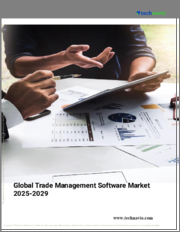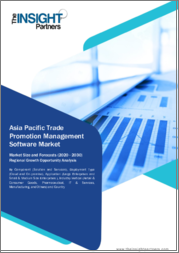
|
시장보고서
상품코드
1738635
세계의 무역 관리 소프트웨어 시장 규모 : 솔루션 유형별, 전개 모델별, 최종사용자 산업별, 지역별, 범위 및 예측Global Trade Management Software Market Size By Type Of Solution, By Deployment Model, By End-User Industry, By Geographic Scope And Forecast |
||||||
무역 관리 소프트웨어 시장 규모 및 예측
무역 관리 소프트웨어 시장 규모는 2024년에 13억 1,000만 달러로 평가되었고, 2026-2032년 10.50%의 연평균 복합 성장률(CAGR)로 성장하여 2032년에는 29억 2,000만 달러에 달할 것으로 예측됩니다.
- 무역 관리 소프트웨어는 세계 무역 및 공급망 관리와 관련된 복잡한 업무를 간소화하고 자동화하는 디지털 솔루션입니다. 이 소프트웨어는 국제 무역법 준수, 문서화, 물류, 금융 거래 등 다양한 무역 관련 업무를 관리할 수 있도록 지원합니다.
- TMS는 상품 수출입과 관련된 복잡한 절차를 간소화하고 최적화하는 완벽한 기능을 갖추고 있기 때문에 국제 무역 기업에게 매우 중요합니다. 컴플라이언스 관리는 가장 일반적인 TMS 용도 중 하나입니다. 기업은 국제 무역을 할 때 복잡한 규제, 관세, 무역 협정의 그물망을 통과해야 합니다.
- 향후 무역 관리 소프트웨어의 활용은 데이터 분석 및 의사 결정 능력을 강화할 것입니다. 무역 데이터의 양과 복잡성이 증가함에 따라 기업은 이를 성공적으로 평가할 수 있는 강력한 소프트웨어 도구가 필요합니다. 고급 분석 및 인공지능(AI) 기능을 갖춘 무역 관리 소프트웨어는 기업이 공급망 운영을 더 잘 이해하고, 추세를 인식하고, 정보에 입각한 의사결정을 내리는 데 도움이 될 수 있습니다.
무역 관리 소프트웨어 세계 시장 역학
주요 시장 성장 촉진요인
- 세계화와 국제 무역의 확대: 세계화와 국제 무역의 확대는 무역 관리 소프트웨어 시장의 주요 촉진요인입니다. 조직이 국경을 넘어 확장함에 따라 무역법, 관세, 물류 관리의 어려움이 증가하고 있습니다. 기업은 수많은 국제 무역 프로세스를 자동화하고 간소화하는 무역 관리 소프트웨어를 통해 이러한 복잡성을 해결할 수 있습니다.
- 규제 준수 및 리스크 관리: 또 다른 중요한 동기는 규제 준수 및 리스크 관리의 필요성입니다. 국제 무역에서는 다른 국가가 부과하는 많은 규제와 기준을 준수해야 합니다. 이러한 규정을 준수하지 않을 경우, 심각한 처벌, 법적 영향, 평판 훼손을 초래할 수 있습니다.
- 효율성 및 비용 절감: 무역 관리 소프트웨어는 국제 무역에 종사하는 기업의 효율성을 높이고 비용을 절감합니다. 무역 관리의 수작업은 시간이 오래 걸리고 실수가 발생하기 쉬워 지연과 운영 비용 증가를 초래합니다. 무역 관리 소프트웨어는 서류 작성부터 통관, 화물 추적, 재고 관리까지 모든 것을 자동화합니다.
주요 과제
- 기존 시스템과의 통합 무역관리 소프트웨어와 기존 시스템과의 통합은 도입 과정에서 가장 어려운 과제 중 하나입니다. 많은 기업들이 레거시 시스템, ERP 플랫폼, 기타 소프트웨어 툴을 조합하여 사용하고 있습니다.
- 규제 준수: 무역 관리 소프트웨어는 복잡한 국제 무역 규제와 컴플라이언스 의무의 그물망을 통과해야 합니다. 이러한 규정은 국가마다 크게 다르며 정기적으로 변경되기 때문에 소프트웨어가 항상 최신 상태를 유지하기가 어렵습니다.
- 데이터 보안 및 프라이버시: 또 다른 중요한 문제는 민감한 무역 데이터의 보안과 기밀성을 보장하는 것입니다. 무역 관리 소프트웨어는 화물 세부 정보, 금융 거래, 고객 데이터 등 수많은 중요한 정보를 취급합니다. 이 데이터를 사이버 위협, 침해, 무단 액세스로부터 보호하는 것은 매우 중요합니다.
주요 동향
- 개발 기술과의 통합: 무역 관리 소프트웨어의 주요 발전 중 하나는 인공지능(AI), 머신러닝(ML), 블록체인 등 개발 기술의 통합입니다. 이러한 기술은 복잡한 활동을 자동화하고, 정확도를 높이고, 실시간으로 정보를 제공함으로써 무역 관리 소프트웨어의 기능을 향상시킵니다.
- 컴플라이언스 및 리스크 관리의 중요성: 또 다른 주목할 만한 트렌드는 컴플라이언스 및 리스크 관리의 중요성이 높아지고 있다는 점입니다. 기업은 처벌이나 중단을 피하기 위해 시시각각 변화하는 국제 무역 규제에 대응해야 합니다. 무역 관리 소프트웨어에는 종합적인 컴플라이언스 툴이 탑재되어 있어 기업이 복잡한 세계 무역 규제망을 통과할 수 있도록 돕습니다.
- 사용자 경험 및 접근성 향상: 무역 관리 소프트웨어는 보다 사용자 친화적인 인터페이스와 접근성을 향상시켰습니다. 최신 소프트웨어 솔루션은 직관적인 인터페이스를 통해 복잡한 무역 절차를 간소화하고, 다양한 수준의 전문 지식을 가진 사용자들이 쉽게 사용할 수 있습니다. 클라우드 기반 시스템은 점점 더 널리 보급되고 있으며, 사용자는 언제 어디서나 다양한 장치에서 소프트웨어에 액세스할 수 있습니다.
목차
제1장 서론
- 시장의 정의
- 시장 세분화
- 조사 방법
제2장 주요 요약
- 주요 조사 결과
- 시장 개요
- 시장 하이라이트
제3장 시장 개요
- 시장 규모와 성장 가능성
- 시장 동향
- 시장 성장 촉진요인
- 시장 성장 억제요인
- 시장 기회
- Porter의 Five Forces 분석
제4장 무역 관리 소프트웨어 시장 : 솔루션 유형별
- 무역 컴플라이언스 관리
- 무역 파이낸싱 관리
- 공급망 시각화 및 추적
제5장 무역 관리 소프트웨어 시장 : 전개 모델별
- On-Premise
- 클라우드 기반
제6장 무역 관리 소프트웨어 시장 : 최종사용자 산업별
- 제조업
- 소매 및 소비재
- 물류 및 운송
제7장 지역별 분석
- 북미
- 미국
- 캐나다
- 멕시코
- 유럽
- 영국
- 독일
- 프랑스
- 이탈리아
- 아시아태평양
- 중국
- 일본
- 인도
- 호주
- 라틴아메리카
- 브라질
- 아르헨티나
- 칠레
- 중동 및 아프리카
- 남아프리카공화국
- 사우디아라비아
- 아랍에미리트(UAE)
제8장 시장 역학
- 시장 성장 촉진요인
- 시장 성장 억제요인
- 시장 기회
- COVID-19의 시장에 대한 영향
제9장 경쟁 구도
- 주요 기업
- 시장 점유율 분석
제10장 기업 개요
- Oracle Corporation
- SAP SE
- E2open
- Descartes Systems Group Inc.
- Livingston International Inc.
- Thomson Reuters
- 3rdWave
- QAD Inc.
- Accuity
제11장 시장 전망과 기회
- 신기술
- 향후 시장 동향
- 투자 기회
제12장 부록
- 약어 리스트
- 출전 및 참고문헌
Trade Management Software Market Size And Forecast
Trade Management Software Market size was valued at USD 1.31 Billion in 2024 and is projected to reach USD 2.92 Billion by 2032, growing at a CAGR of 10.50% from 2026 to 2032.
- Trade management software is a digital solution that simplifies and automates the complicated operations involved in global trade and supply chain management. This software assists firms in managing a variety of trade-related activities including compliance with international trade legislation, documentation, logistics, and financial transactions.
- TMS is critical for international trade enterprises owing to it complete capability of streamlining and optimizing the complex procedures of importing and exporting commodities. Compliance management is one of the most common TMS applications. Businesses must traverse a complex web of regulations, tariffs, and trade agreements while doing international trade.
- The future use of trade management software will enhance data analytics and decision-making capabilities. As the volume and complexity of trade data increases, organizations will require powerful software tools to successfully evaluate it. Trade management software with advanced analytics and artificial intelligence (AI) capabilities can help businesses obtain a better understanding of their supply chain operations, recognize trends, and make informed decisions.
Global Trade Management Software Market Dynamics
The key market dynamics that are shaping the global trade management software market include:
Key Market Drivers:
- Globalization and Expansion of International Trade: Globalization and the expansion of international trade are key drivers of the Trade Management Software Market. As organizations expand across borders, the difficulty of managing trade legislation, tariffs, and logistics increases. Companies can handle this complexity with trade management software which automates and streamlines numerous international trade processes.
- Regulatory Compliance and Risk Management: Another important motivator is the necessity for regulatory compliance and risk management. International trade entails conforming to a slew of regulations and standards imposed by other countries. Noncompliance with these regulations can result in significant penalties, legal consequences, and reputational damage.
- Efficiency and Cost Reduction: Trade management software improves efficiency and lowers costs for businesses involved in international trade. Manual processes in trade management are time-consuming and error-prone resulting in delays and higher operational expenses. Trade management software automates everything from documentation and customs clearance to shipment tracking and inventory management.
Key Challenges:
- Integration with Existing Systems: Integrating trade management software with current systems is one of the most difficult aspects of the implementation process. Many firms use a combination of legacy systems, ERP platforms, and other software tools that have been developed or acquired over time.
- Regulatory Compliance: Trade management software must navigate a complicated web of international trade regulations and compliance obligations. These restrictions might differ greatly from one country to the next and change regularly making it difficult for the software to stay current.
- Data Security and Privacy: Another key difficulty is guaranteeing the security and confidentiality of sensitive trade data. Trade management software handles a large number of vital information such as shipment details, financial transactions, and customer data. Protecting this data from cyber threats, breaches, and illegal access is critical.
Key Trends:
- Integration with Developing Technologies: One of the major developments in trade management software is the incorporation of developing technologies such as artificial intelligence (AI), machine learning (ML), and blockchain. These technologies improve the functionality of trade management software by automating complex activities, increasing accuracy, and delivering real-time information.
- Focus on Compliance and Risk Management: Another noteworthy trend is an increased emphasis on compliance and risk management. Businesses must keep up with ever-changing international trade regulations to avoid penalties and interruptions. Trade management software now incorporates comprehensive compliance tools to help businesses traverse the intricate web of global trade regulations.
- Improved User Experience and Accessibility: Trade management software is also improving to provide a more user-friendly interface and increased accessibility. Modern software solutions have intuitive interfaces that simplify complex trade procedures making them easier to use for users of various levels of expertise. Cloud-based systems are becoming increasingly popular allowing users to access software from anywhere at any time and on a variety of devices.Dwnload Sample
Global Trade Management Software Market Regional Analysis
Here is a more detailed regional analysis of the global Trade Management Software Market:
North America:
- North America dominates the Trade Management Software Market accounting for the biggest worldwide market share. According to the United States Census Bureau, the total value of U.S. foreign trade in goods and services will be around USD 6.5 Trillion in 2023, with USD 3.0 Trillion coming from exports and USD 3.5 Trillion from imports. This large amount of trade highlights the need for effective trade management solutions in the region. According to the United States Bureau of Economic Analysis, the information and communication technology (ICT) industry will account for around 6.8% of US GDP in 2022 emphasizing the importance of technology in a variety of industries, including trade management.
- Furthermore, Statistics Canada estimated that in 2022, Canada's overall goods trade would exceed CAD 1.52 trillion highlighting the complexity of trade operations in the region that necessitate sophisticated management solutions. According to the World Bank's Logistics Performance Index (LPI), the United States and Canada are consistently ranked among the top 20 countries in the world demonstrating excellent logistics and trade infrastructure that fosters trade management software usage.
Asia Pacific:
- The trade management software industry in Asia Pacific is expanding rapidly with China and India leading the way. The Asian Development Bank (ADB) reports that the Asia Pacific region's trade volume will reach USD 9.5 Trillion in 2021, accounting for roughly 35% of global commerce. This significant commercial activity is increasing the demand for effective trade management software solutions. According to the United Nations Economic and Social Commission for Asia and the Pacific (UNESCAP), digital trade facilitation implementation in the region increased from 46.5% in 2019 to 64.9% in 2021, showing an increasing use of digital technologies for trade management.
- The World Trade Organization (WTO) believes that lowering trade costs in the Asia Pacific by 15% could boost regional GDP by up to 2.7% demonstrating the potential impact of streamlined trade processes. Furthermore, the Asia-Pacific Economic Cooperation (APEC) reports that its member economies have implemented more than 60% of the steps included in the APEC Trade Facilitation Action Plan demonstrating a commitment to improving trade efficiency through technological adoption.
Global Trade Management Software Market: Segmentation Analysis
The Global Trade Management Software Market is segmented on the basis of Type Of Solution, Deployment Model, End-User Industry, and Geography.
Trade Management Software Market, By Type Of Solution
- Trade Compliance Management
- Trade Finance Management
- Supply Chain Visibility And Tracking
Based on Type Of Solution, the Global Trade Management Software Market is bifurcated into Trade Compliance Management, Trade Finance Management, Supply Chain Visibility, and Tracking. In the global trade management software market, trade compliance management solutions are dominant. This dominance is driven by the increasing complexity of international trade regulations and the significant financial and operational risks associated with non-compliance. Businesses operating globally must navigate a complex web of regulations that vary by country and are subject to frequent changes. Trade compliance management software helps companies automate compliance processes ensuring they meet all regulatory requirements efficiently and accurately.
Trade Management Software Market, By Deployment Model
- On-Premises
- Cloud-Based
Based on Deployment Model, the Global Trade Management Software Market is bifurcated into On-Premises and Cloud-Based. The cloud-based deployment model is dominant in the global Trade Management Software Market. This dominance is driven by several factors including the flexibility, scalability, and cost-effectiveness of cloud-based solutions. Cloud-based trade management software allows businesses to access their systems from anywhere at any time facilitating remote work and global operations. It eliminates the need for substantial upfront investments in hardware and infrastructure making it more affordable, especially for small and medium-sized enterprises (SMEs).
Trade Management Software Market, By End-User Industry
- Manufacturing
- Retail and Consumer Goods
- Logistics and Transportation
Based on End-User Industry, the Global Trade Management Software Market is bifurcated into Manufacturing, Retail and Consumer Goods, and Logistics, and Transportation. In the global Trade Management Software Market, the manufacturing sector is dominant. This dominance is driven by the sector's complex supply chains and the need for efficient management of international trade operations. Manufacturers deal with a vast network of suppliers, distributors, and regulatory requirements across multiple countries. Trade management software helps manufacturers streamline these processes ensuring compliance with global trade regulations, reducing costs, and improving supply chain efficiency. The ability to manage import and export activities, track shipments in real-time, and automate documentation processes is crucial for manufacturers to maintain competitiveness and operational efficiency.
Key Players
The "Global Trade Management Software Market" study report will provide valuable insight with an emphasis on the global market. The major players in the market are Oracle Corporation, SAP SE, E2open, Descartes Systems Group, Inc., Livingston International, Inc., Thomson Reuters, 3rdWave, QAD, Inc., and Accuity.
Our market analysis also entails a section solely dedicated to such major players wherein our analysts provide an insight into the financial statements of all the major players, along with product benchmarking and SWOT analysis. The competitive landscape section also includes key development strategies, market share, and market ranking analysis of the above-mentioned players globally.
Global Trade Management Software Market Key Developments
- In December 2023, Citi announced a collaboration with Traydstream to provide automated trade-document processing capabilities to users worldwide.
- In February 2024, Oracle's worldwide trade management and transportation management applications, which are essential components of Oracle's Cloud Supply Chain and Manufacturing (SCM) suite, were enhanced with additional capabilities. These featured increased business intelligence capabilities and sophisticated logistics network modeling.
TABLE OF CONTENTS
1. Introduction
- Market Definition
- Market Segmentation
- Research Methodology
2. Executive Summary
- Key Findings
- Market Overview
- Market Highlights
3. Market Overview
- Market Size and Growth Potential
- Market Trends
- Market Drivers
- Market Restraints
- Market Opportunities
- Porter's Five Forces Analysis
4. Trade Management Software Market, By Type Of Solution
- Trade Compliance Management
- Trade Finance Management
- Supply Chain Visibility and Tracking
5. Trade Management Software Market, By Deployment Model
- On-Premises
- Cloud-Based
6. Trade Management Software Market, By End-User Industry
- Manufacturing
- Retail And Consumer Goods
- Logistics And Transportation
7. Regional Analysis
- North America
- United States
- Canada
- Mexico
- Europe
- United Kingdom
- Germany
- France
- Italy
- Asia-Pacific
- China
- Japan
- India
- Australia
- Latin America
- Brazil
- Argentina
- Chile
- Middle East and Africa
- South Africa
- Saudi Arabia
- UAE
8. Market Dynamics
- Market Drivers
- Market Restraints
- Market Opportunities
- Impact of COVID-19 on the Market
9. Competitive Landscape
- Key Players
- Market Share Analysis
10. Company Profiles
- Oracle Corporation
- SAP SE
- E2open
- Descartes Systems Group Inc.
- Livingston International Inc.
- Thomson Reuters
- 3rdWave
- QAD Inc.
- Accuity
11. Market Outlook and Opportunities
- Emerging Technologies
- Future Market Trends
- Investment Opportunities
12. Appendix
- List of Abbreviations
- Sources and References



















